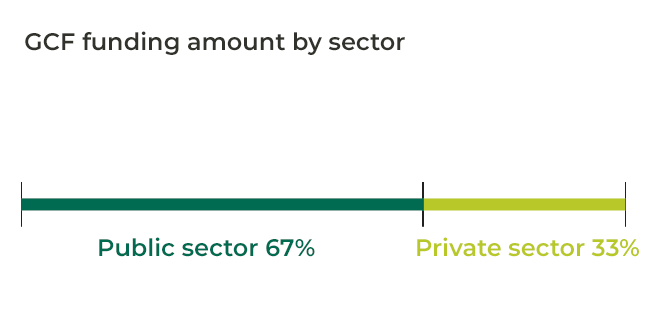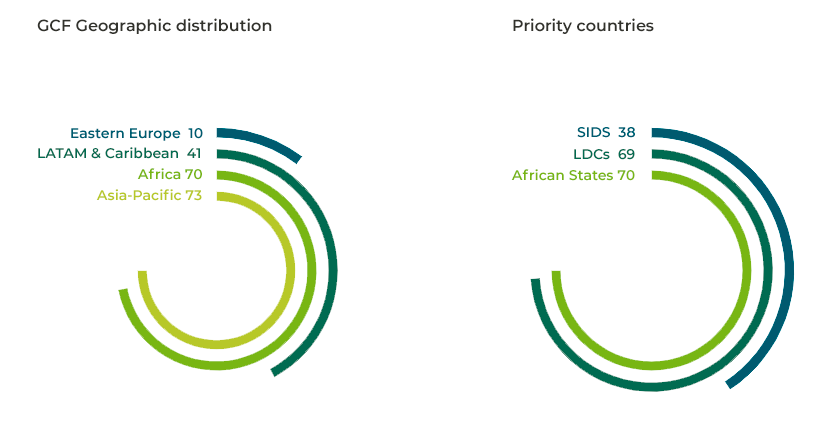In 2015, the Conference of the Parties, also known as COP 21 and the Paris Climate Conference, invited the Board of the Green Climate Fund (GCF) to consider ways to facilitate access to environmentally sound technologies in developing countries, and to undertake collaborative research and development that could help enhance both mitigation and adaptation action. Since then, the GCF has focused on “considering projects and programs with a focus on fostering innovation and technology for mitigation and adaptation and has approved 177 projects amounting to $8.8 billion in funding for a total investment value of over $33.2 billion.
Source: GCF
Of those 177 projects, approximately 66% have a technology component, 43% focus on mitigation, 32% on adaptation, and 25% cross cutting.
The top three areas for investment in technology related to mitigation are:
- Energy generation and access to electricity.
- Forest and land use.
- Building cities, industries, and appliances portfolio of projects.
The projects that relate to technology adaptation generally fall under:
- Infrastructures which build environment systems.
- Ecosystems and ecosystems technologies, specifically technologies related to sea walls, monitoring systems, and hazard mapping.
While these technology projects and the significant funding behind them are promising for the future of sustainability, the GCF’s technology portfolio falls short in fostering breakthrough climate technologies in regards to incubators and accelerators. Furthermore, the fund is lagging behind in fully supporting article 10 of the Paris Agreement, which states that accelerating, encouraging, and enabling innovation is not only critical for an effective, long-term global response to climate change but for promoting economic growth and sustainable development. Unfortunately, the research, development, and commercialization of climate technologies is currently hampered by insufficient risk-tolerant capital and a lack of wide-ranging public blended financing instruments that can unlock private sector investments. This is in contrast to the financing that has been made available for clean water and sanitation.
Private investors commonly seek a safe return on their investment, but innovation is seldom risk free. This is where the GCF and other financial institutions can help by playing a central role in “de-risking” private investment in a high-risk asset class such as innovative early-stage climate technology companies. In addition, they can create a pipeline of investible companies and bankable projects by financially supporting the likes of innovation centers, incubators, and accelerators.
The newly proposed Climate Technology Incubators and Accelerators RFP, which will be presented to the Board later this year, addresses these climate technology gaps with up to USD $180 million of GCF funding for incubators and accelerators in the form of grant, equity, debt, and guaranteed financing that amplifies the climate technologies’ impact and promotes development objectives such as adopting a gender-sensitive approach. This seems like an obvious opportunity but climate technology incubators, accelerators, and innovation hubs face various challenges and limitations, for example:
- They are often financed primarily by scarce public sector resources, rather than by the copious private sector.
- Investors often have a bias towards later-maturity stage companies and mitigation-related activities and thus tend to be wary of supporting early-stage companies and adaptation-related activities.
- While many countries have research and innovation centers, they are not well linked to potential users, new applications, and markets.
- There is a general lack of understanding on both the public and institutional level of the wide range of available climate technology solutions, how to develop markets for scaling, and how these solutions are applicable in a given country context.
- More support is needed in product development and market analysis in order for companies and national technology assessments to prioritize the most promising climate technology solutions for their particular country.
- The institutional, regulatory, and political frameworks are often not locally relevant and thus hinder the success rate of region-specific climate technology solutions and interventions.
- Developing countries, in particular, often have weak entrepreneurial support systems that result in fragmented linkages to existing or potential climate technology markets. In addition, there is a lack of financing for entrepreneurial activities, making it difficult to compete with the economies of scale achieved by international companies.
Simply put, in order to address the weak linkages between research and innovation bodies within and between countries, additional financial support is needed. This capital is also necessary to educate the public on the range of climate technology solutions available and how they apply in a given context. Furthermore, an influx of finance is needed in particular to bring locally relevant climate technology solutions to developing countries that face varying institutional, regulatory, and political framework conditions, and insufficient entrepreneurial support systems.
Climate technology incubators and accelerators in developing countries should ideally fit within the nation’s specific priorities. Because climate disasters are currently and will continue to impact developing countries harder and faster than developed countries, there is an impending need for innovation and scale, particularly for adaptation and technology incubation whilst promoting co-benefits, such as private sector investment, economic growth, environmental impacts, gender-sensitive, and resilient pathways development.
Source: GCF
By deepening the pool of climate-focused technology entrepreneurs in developing countries, new financial resources would foster the creation of more innovative models for climate technology incubators and in turn come up with more localized, community-based, and ad hoc technology solutions In parallel, infrastructure, such as IT connectivity and best practices must be enhanced in order to develop and promote training and education programs – both for the entrepreneurs participating in the incubators and accelerators and for the professionals that manage them. Similarly, new financial resources would help to connect the national ecosystems with other national, regional, and global ecosystems and thus spur innovative ideas, networks, knowledge, and scaling opportunities
The concept of crowding private finance for technology development is key for the health of the entrepreneurial ecosystem, particularly in regards to climate technology markets, because it attracts both players and solutions and increases demand for exploring new incubation and acceleration models. There is hope that earmarking financial resources for climate breakthrough technologies will foster carbon-free electricity generation, a decarbonized power grid, affordable and grid-scaled batteries, carbon capture and storage, energy efficiency, green materials, minimized food waste, and decarbonized transportation and tourism – all while promoting advanced early warning systems, mangroves and sea walls, climate-resilient infrastructure and water management. This is but to name a few, for the list is long and has the potential to be longer.
© IE Insights.











